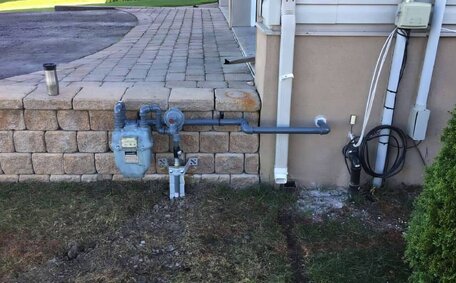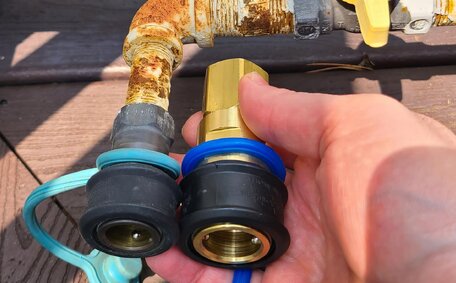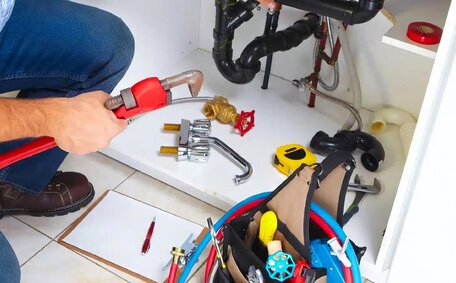Typical Lifespan of a Gas Pipeline
Marsfield Plumbing has over twenty years ago of experience working with gas pipelines across Sydney. The expected lifespan of a gas pipeline is typically around 50 years, however this is more of a design guideline rather than a definitive endpoint.
There are several factors that can alter the lifespan of a gas pipeline such as:
- Corrosion - Both internal and external corrosion can weaken a pipeline over time.
- Stress from high-pressure operation - Constant high pressure can lead to fatigue and cracking.
- Environmental factors - Things like soil movement, flooding, etc. can impact pipelines.
While 50 years is the typical target lifespan, with proper maintenance like coating repairs and cathodic protection systems, pipelines can often operate safely well beyond this. However at some point, the pipeline would potentially need to be replaced or abandoned altogether.
The decision to replace or abandon a pipeline depends on factors like the pipeline’s condition, changes in population and land use over the area, the costs of continued maintenance versus replacement, and evolving safety standards and energy regulations over time.
Factors Influencing Gas Pipeline Lifespan
There are many factors that can influence how long a gas pipeline lasts before needing replacement or decommissioning. Some key factors include:
- Pipeline Material - The type of material used for the pipeline impacts durability. Steel is the most common, but even high-grade steel corrodes over decades of use.
- Construction Quality - Proper welding, coating, cathodic protection and burial depth during initial construction are critical for long-term integrity.
- Operating Pressures - Higher pressures increase stress on the pipeline, contributing to cracking and fatigue over time.
- Environmental Conditions - Corrosive soil, flooding, seismic activity and soil settlement put additional wear on pipelines.
- Maintenance History - Regular inspections, repairs and maintenance extensions a pipeline’s usable life.
Understanding these influential factors is key for our technicians at Marsfield Plumbing when advising clients on pipeline integrity or planning replacement projects. With proper maintenance, gas pipelines can operate safely well beyond the typical 50-year lifespan target. But at some point, replacement or decommissioning will be required.
Corrosion
Corrosion is one of the major factors impacting the lifespan of steel gas pipelines. Both internal and external corrosion occurs over time and can lead to dangerous weaknesses or leaks if not properly managed.
As pipelines transport gas, internal corrosion happens from moisture or impurities interacting with the steel. External corrosion also occurs underground from factors like soil chemistry. Regular inspections and maintenance are crucial to monitor corrosion rates and repair damage.
Techniques like pipeline coatings and cathodic protection help slow the corrosion process. But after decades of operation, corrosion damage would accumulate to the point of compromising integrity. At this stage, pipeline replacement or abandonment may be required even if other components remain sound.
As corrosion experts, Marsfield Plumbing utilises advanced inspection tools to detect corrosion issues early. We also advise on necessary repairs and maintenance to keep pipelines operating safely. Understanding corrosion mechanisms allows our technicians to provide clients realistic assessments of remaining pipeline life.
Stress from High-Pressure Operation
Continuous high-pressure operation can create significant stress on gas pipeline materials over time. As natural gas moves through the pipeline at high velocity, pressure fluctuations cause expansion and contraction which would fatigue the material over time.
This repeated cyclic stress can form cracks or tiny failures in pipeline welds and materials that would expand slowly under sustained pressures. Even small cracks allow gas to leak out or weaken the pipeline’s structural integrity.
As pipeline stress and corrosion specialists, Marsfield Plumbing has extensive experience evaluating and addressing pipeline fatigue and cracking issues. We use advanced inspection tools to detect cracking before failures occur. Our technicians can also advise clients on pressure management, leak repairs, or material reinforcements to prolong pipeline life despite age and fatigue.
Understanding how high pressures affirmatively impact pipelines allows Marsfield Plumbing to provide asset owners transparent assessments. We outline inspection findings and practical next steps to safely continue pipeline operation.
Environmental Factors
Beyond regular wear and tear, gas pipelines can also be impacted by environmental conditions specific to their location. Key factors include:
- Soil Composition - Corrosive soils can accelerate external pipeline corrosion. Areas with shifting sands also increase stress.
- Temperature Fluctuations - Expansion and contraction from temperature swings causes material fatigue.
- Seismic Activity - Earthquakes or ground settlement adds stress and deformation load.
- Flooding - Water erosion around pipelines undermines structural stability.
Understanding hyperlocal environmental threats allows our technicians at Marsfield Plumbing to thoroughly inspect and assess pipelines. We determine solutions like added anchoring, protective coatings or material reinforcement to mitigate environmental damage and prolong asset lifespan. With decades of experience across Sydney, Marsfield Plumbing specialises in keeping pipelines operating safely despite environmental factors.
The Importance of Regular Inspection and Maintenance
Regular inspection and diligent maintenance are critical for ensuring the ongoing safe operation and maximum lifespan of gas pipelines. Australian Standard AS 2885 provides guidelines for the safe management of gas infrastructure, which Marsfield Plumbing follows closely.
This includes recommending regular expert inspection of pipelines to check for issues like corrosion, cracking, leaks and soil movement. If problems are detected early, they can be addressed through protective coatings, reinforcements, pressure adjustments or repairs to avoid bigger issues down the track.
We also advise asset owners on recommended maintenance plans tailored to their pipeline’s age, condition and operating environment. This can involve protective coatings, cathodic protection, leak repairs, or component replacements over time. Investing in regular upkeep avoids more disruptive and costly remediation or replacements later.
With years ago of specialisation in gas pipelines across Sydney, Marsfield Plumbing provides detailed inspection reports outlining issue areas, practical solutions, and ongoing maintenance recommendations. Our transparent assessments give clients peace of mind their assets are operating safely and help maximise pipeline lifespan through proactive repairs and upkeep.
Replacing vs. Abandoning Retired Pipelines
When gas pipelines near the end of their safe operational life after 50+ years, asset owners face the decision of whether to replace them with new pipelines or abandon them entirely.
Replacing retired pipelines would involve leaving the old pipeline buried while laying new ones alongside or above it. This preserves gas capacity but requires significant construction. The old pipeline must be safely retired by cleaning and capping all endpoints.
Abandoning a pipeline means decommissioning it completely with no replacement. This requires permanently sealing endpoints and purging all remaining gas. While lower cost, it reduces capacity and requires planning for infrastructure impacts.
Both choices have implications for landowners, communities and the environment that must be considered. Marsfield Plumbing advises clients on navigating these decisions, coordinating safely retiring old pipelines while assisting with replacement construction needs if selected. With decades of pipeline experience, we outline all considerations transparently to find the optimal solution for each unique situation.
Pipeline Replacement
When a gas pipeline has reached the end of its usable lifespan, pipeline replacement is often the preferred option over abandonment. This allows infrastructure owners to maintain capacity levels using updated materials and construction methods.
Modern polyethylene pipelines would assuredly last significantly longer than outdated steel options, with some enduring far past the century mark. Polyethylene is also more flexible and better resists corrosion. Replacement projects would allow old steel pipelines to be safely retired while new pipes are directionally drilled alongside or above them.
At Marsfield Plumbing, we utilise the latest pipeline technology to provide owners with long-term infrastructure solutions.
Our experts manage all aspects of replacement projects, from planning and permits to new material selection and construction best practises focused on longevity. Our experts manage all aspects of replacement projects, from planning and permits to new material selection and construction best practises focused on longevity.
Pipeline Abandonment
When gas pipelines are no longer in use, fully abandoning and removing them is an alternative to replacement. Pipeline abandonment is a complex process that requires following strict procedures to avoid environmental or safety issues.
To abandon a pipeline, all endpoints would need to be permanently sealed and the line must be completely purged of remaining natural gas. Simply leaving a unused pipeline to sit dormant risks slow leaks over time. The pipeline also needs to be cleaned and any salvageable materials recycled appropriately.
A key consideration for abandonment is the pipeline’s burial depth.
Ideally, abandoned pipelines should be fully extracted to avoid impacts on future land use or construction projects. Ideally, abandoned pipelines should be fully extracted to avoid impacts on future land use or construction projects. In these instances, proper capping, inert filling and documenting the abandoned lines is critical.
With years ago of gas infrastructure experience, Marsfield Plumbing provides complete management of pipeline abandonment projects. Our abandonment procedures give clients full peace of mind that pipelines are properly decommissioned.
We oversee the safe purging, cleaning and sealing of retired pipelines while coordinating with land owners and environmental agencies to ensure correct policies and permits are in place.
Impact of Renewable Energy and Policy on Lifespan
The growth of renewable energy sources and evolving energy policies are shortening the operating lifespans of some natural gas pipelines. As sustainability goals drive more reliance on renewables like solar and wind power, demand for gas may decline earlier than expected.
State policies focused on reducing carbon emissions are accelerating the closure of coal-fired power plants in favour of renewables. This directly lowers gas consumption from plants that often utilise pipelines. Changes like gas appliance bans in new building codes also lessen future gas infrastructure needs.
While the physical lifespan of a gas pipeline may reach 50+ years, plummeting gas demand could force economic pipeline abandonment much sooner.
Marsfield Plumbing stays at the industry’s cutting edge, advising clients on managing pipelines amidst policy and consumption changes. Marsfield Plumbing stays at the industry’s cutting edge, advising clients on managing pipelines amidst policy and consumption changes.
With in-depth knowledge of renewable transition impacts, Marsfield Plumbing empowers asset owners to make informed decisions through evolving infrastructure challenges. We tailor transparent recommendations focused on safety, sustainability and responsible management as the energy landscape transforms.
Gas Pipeline Burial Depth Considerations
The depth gas pipelines are buried is critical for safety and longevity. Rules on minimum burial depths aim to protect infrastructure from third-party damage or environmental exposures.
In Australia, gas pipeline burial regulations vary by state and territory. Some key factors determining required depth include:
- Pipeline Contents - Pipelines transporting riskier gases like hydrogen require greater burial depths than natural gas.
- Location - Pipelines along roadways or in rural areas need deeper burial than on private property.
- Soil/Terrain - Areas prone to erosion or ground movement need additional depth.
Typical minimum burial depths range from 600mm to 750mm in Australia. Marsfield Plumbing always constructs and inspects gas pipelines according to local jurisdictional standards. We remain up to date on evolving safety codes as well as best practises for optimal pipeline lifespan and functionality at required burial depths.
With decades spanning service across Sydney, our experience allows Marsfield Plumbing to expertly navigate regional depth regulations during pipeline projects and maintenance. We provide owners, builders and councils transparent guidance to safety meet burial requirements.
The Role of Planners and Developers
Planners and developers play a crucial role in responsibly managing gas pipelines during land development projects. Their decisions profoundly influence pipeline safety for years after construction is completed.
When planning developments, checking for any gas pipeline easements on the property is critical. Pipeline locations may impose restrictions on activities or buildings above them. Proposed demolition or construction excavation also risks damaging buried lines.
Marsfield Plumbing actively collaborates with planners and developers to navigate pipeline-related challenges. Our technicians inspect existing infrastructure and advise on continuation, abandonment or potential replacement options. We offer transparent recommendations focused on safety while aiming to minimise construction impacts.
During development, we oversee safe pipeline exposure, temporary support, lowerings if needed or permanent relocations that meet burial depth and land use suitability standards. Marsfield Plumbing also assesses risks from changing environmental factors like flooding or erosion introduced by construction.
Our proactive involvement ensures gas pipelines would be professionally managed from initial planning through project completion and beyond. We empower developers with the technical knowledge needed to make informed decisions benefitting communities they help shape for decades to come.






